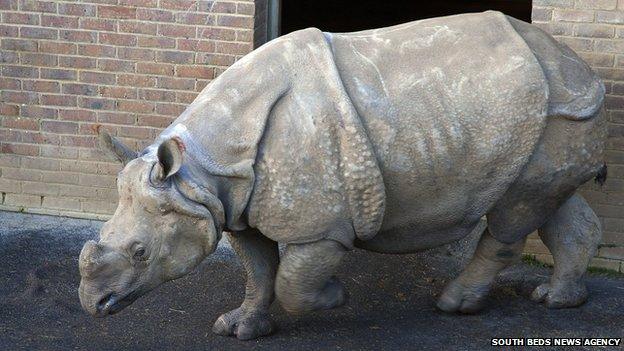Whipsnade Zoo: 'No action' over injured rhino keeper
- Published

The zookeeper was found by other members of staff in an enclosure
An investigation into how a zookeeper was seriously injured by a rhino at Whipsnade Zoo has been unable to establish the cause.
The man was found by colleagues in water at the zoo, near Dunstable, last November.
Central Bedfordshire Council said it would not release its full report but officials had concluded no further action was needed.
The zoo said it would continue to work on health and safety procedures.
'Immersed in water'
The keeper, who is in his 50s, was found in the Asian rhino enclosure with injuries to his chest, abdomen and pelvis.
Paramedics kept him warm after his body temperature had dropped considerably from being immersed in water.
He was taken to Addenbrooke's Hospital in Cambridge in a "serious" condition.
The zoo said it would not comment on the keeper's health or medical history as that is "a private matter"
But it had "worked closely" with the council during the investigation and "would continue to work with them on all aspects of health and safety", a spokesperson said.
A council spokesman said its public protection officers had conducted a "lengthy investigation and review" which considered evidence from "all key parties and witnesses" and concluded no further action was necessary.
"[We have] offered advice and recommendations around improving policies and procedures," he said.
The authority said it would not be releasing more details as much of the information obtained was "subject to strict disclosure rules".


Five Asian rhinos live in the enclosure where the incident happened, the zoo said
Asian rhinos
Species include, external the greater one-horned rhino (Rhinoceros unicornis), Javan rhino (R. sondaicus) and Sumatran rhino (Dicerorhinus sumatrensis)
Whipsnade Zoo has greater one-horned rhinos in its Rhinos of Nepal enclosure
There are about 2,500 such animals left in the wild - the overall population has slowly increased from as few as 200 at the beginning of the 20th Century
Instead of using horns to fight, the males use long, sharp lower teeth
They are very good swimmers and spend up to 60% of the day wallowing
Source: World Wild Life Fund and ZSL

- Published22 December 2014

- Published20 November 2014

- Published19 November 2014
